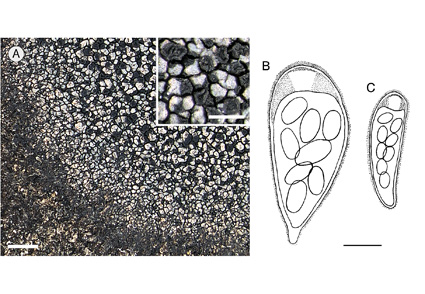Abstract
Two new species of Lambiella Hertel from Tasmania are described and illustrated: L. parvipsephota Kantvilas, which is similar to the widespread L. psephota (Tuck.) Hertel but differs by lacking norstictic acid in the thallus and sedifolia-grey pigment in the apothecia, and by having smaller apothecia and ascospores, 8−13 × 5−7.5 µm; and L. plumbea Kantvilas, characterised by a grey thallus lacking lichen substances, minute apothecia 0.075−0.13 mm wide, and small ascospores 4−8.5 × 3−5 µm. Both are currently known only from Tasmania. A further 11 species of Rimularia are transferred to Lambiella: Lambiella albotessellata (Kantvilas) Kantvilas, Lambiella applanata (Kantvilas & Coppins) Kantvilas, Lambiella aspicilioides (Kantvilas) Kantvilas, Lambiella asteriphila (Kantvilas) Kantvilas, Lambiella campestris (Kantvilas & Elix) Kantvilas, Lambiella circumgrisea (Kantvilas) Kantvilas, Lambiella coppinsiana (Kantvilas) Kantvilas, Lambiella exigua (Hertel & Rambold) Kantvilas, Lambiella globulispora (Sipman & Aptroot) Kantvilas, Lambiella ramboldiana (Kantvilas & Elix) Kantvilas and Lambiella umbratilis (Kantvilas & Coppins) Kantvilas. The complexities of assigning many, chiefly Southern Hemisphere taxa to new generic concepts derived essentially from molecular data are discussed briefly. Lambiella is considered to be the genus of best fit for a suite of lichens that share many salient features, particularly with respect to apothecial anatomy and their Trapelia-type asci. An identification key to the 14 species of Lambiella in Tasmania is provided.
References
<p>Aptroot, A. & Sipman, H.J.M. (1991) New lichens and lichen records from New Guinea. <em>Willdenowia</em> 20: 221–256.</p>
<p>Cannon, P., Fryday, A., Spribille, T, Coppins, B., Vondrák, J., Sanderson, N. & Simkin, J. (2021) Baeomycetales: Xylographaceae, including the genera <em>Lambiella</em>, <em>Lithographa</em>, <em>Ptychographa</em> and <em>Xylographa</em>. <em>Revision of British and Irish Lichens</em> 17: 1−11.</p>
<p>Coppins, B.J. & Kantvilas, G. (2001) Four new species of <em>Rimularia</em> Nyl. (Agyriaceae). <em>Bibliotheca Lichenologica</em> 78: 35–48.</p>
<p>Fryday, A.M. & Øvstedal, D.O. (2012) New species, combinations and records of lichenized fungi from the Falkland Islands (Islas Malvinas). <em>Lichenologist</em> 44: 483–500. https://doi.org/10.1017/S0024282912000163</p>
<p>Fryday, A.M., Orange, A., Ahti, T, Øvstedal, D.O. & Crabtree, D.E. (2019) An annotated checklist of lichen-forming and lichenicolous fungi reported from the Falkland Islands (Islas Malvinas). <em>Glalia</em> 8: 1−100.</p>
<p>Hafellner, J. (1984) Studien in Richtung einer natürlicheren Gliederung der Sammelfamilien Lecanoraceae und Lecideaceae. <em>Beiheft zur Nova Hedwigia</em> 79: 241–371.</p>
<p>Halici, M.G., Fryday, A.M., Kahraman Yíğit, M. & Avci, F.N. (2021) An acid deficient population of <em>Lambiella psephota</em> from Antarctica and new combination in the genus from Campbell Island with a world-wide key to the genus. <em>Biological Diversity and Conservation </em>15: 1−9. https://doi.org/10.46309/biodicon.2022.1026394</p>
<p>Hertel, H. (1984) Über saxicole, lecideoide Flechten der Subantarktis. <em>Beiheft zur Nova Hedwigia</em> 79: 399–499.</p>
<p>Hertel, H. & Rambold, G. (1990) Zur Kenntnis der Familie Rimulariaceae (Lecanorales). <em>Bibliotheca Lichenologica</em> 38: 145–189.</p>
<p>Jarman, S.J., Kantvilas, G. & Brown, M.J. (1994) Phytosociological studies in Tasmanian cool temperate rainforest. <em>Phytocoenologia </em>22: 355–390. https://doi.org/10.1127/phyto/22/1994/355</p>
<p>Kantvilas, G. (2014) New species of the genus <em>Rimularia </em>Nyl. from Tasmania. <em>Lichenologist </em>46: 349–364. https://doi.org/10.1017/S0024282913000595</p>
<p>Kantvilas, G. & Elix, J.A. (2007) Additions to the lichen family Agyriaceae Corda from Tasmania. <em>Bibliotheca Lichenologica</em> 95: 317–333.</p>
<p>Kantvilas, G, McCarthy, P.M. & Stuckey, B. (2008) A remarkable new species of <em>Rimularia</em> Nyl. (lichenized fungi: Trapeliaceae) from tropical Australia. <em>Austrobaileya</em> 7: 659–663.</p>
<p>Kistenich, S., Timdal, E., Bendiksby, M. & Ekman, S. (2018) Molecular systematics and character evolution in the lichen family Ramalinaceae (Acomycota: Lecanorales). <em>Taxon</em> 67: 871−904. https://doi.org/10.12705/675.1</p>
<p>Kondratyuk, S.Y., Lőkös, L., Kondratiuk, A.S., Kärnefelt, I., Thell, A., Farkas, E. & Hur, J.-S. (2022) Contributions to molecular phylogeny of lichens 3. New monophyletic branches of the Trapeliaceae and Xylariaceae. <em>Acta Botanica Hungarica</em> 65: 97−135. https://doi.org/10.1556/034.64.2022.1-2.6</p>
<p>Lumbsch, H.T. (1997) Systematic studies in the sub-order Agyriineae (Lecanorales). <em>Journal of the Hattori Botanical Laboratory </em>83: 1–73.</p>
<p>Meyer, B. & Printzen, C. (2000) Proposal for a standardized nomenclature and characterization of insoluble lichen pigments. <em>Lichenologist </em>32: 571–583. https://doi.org/10.1006/lich.2000.0294</p>
<p>McCune, B. & Lumbsch, H.T. (2017) <em>Lambiella arenosa</em>, a new species from the coastal Oregon dunes. <em>Bryologist </em>120: 329−334. https://doi.org/10.1639/0007-2745-120.3.329</p>
<p>Orange, A., James, P.W. & White, F.J. (2010) <em>Microchemical Methods for the Identification of Lichens.</em> 2<sup>nd</sup> edition. British Lichen Society, London.</p>
<p>Orange, A., Cannon, P., Aptroot, A., Coppins, B., Sanderson, N. & Simkin, J. (2021) Baeomycetales: Trapeliaceae, including the genera <em>Coppinsia</em>, <em>Placopsis</em>, <em>Placynthiella</em>, <em>Rimularia</em>, <em>Trapelia</em> and <em>Trapeliopsis</em>. <em>Revision of British and Irish Lichens</em> 18: 1−19.</p>
<p>Øvstedal, D.O., Tønsberg, T. & Elvebakk, A. (2009) The lichen flora of Svalbard. <em>Sommerfeltia </em>33: 1–393. https://doi.org/10.2478/v10208-011-0013-5</p>
<p>Rambold, G. (1989) A monograph of the saxicolous lecideoid lichens of Australia (excl. Tasmania). <em>Bibliotheca Lichenologica</em> 34: 1–345.</p>
<p>Resl, P., Schneider, K., Westberg, M., Printzen, C, Palice, Z, Thor, G., Fryday, A., Mayrhofer, H & Spribille, T (2015) Diagnostics for a troubled backbone: testing topological hypotheses of trapelioid lichenized fungi in a large-scale phylogieny of Ostropomycetidae (Lecanoromycetes).<em> Fungal Diversity</em> 73: 239−258. https://doi.org/10.1007/s13225-015-0332-y</p>
<p>Spribille, T, Resl, P, Ahti, T, Tønsber, T., Mayrhofer, H. & Lumbsch, H.T. (2014) Molecular systematics of the wood-inhabiting, lichen-forming genus <em>Xylographa</em> (Baeomycetales, Ostropomycetidae) with eight new species. <em>Symbolae Botanicae Upsalienses</em> 37 (1): 1−87.</p>
<p>Spribille, T., Fryday, A.M., Pérez-Ortega, S., Svensson, M., Tønsberg, T., Ekman, S., Holien, H., Resl, P., Schneider, K., Stabentheiner, E., Thüs, H., Vondrák, J. & Sharman, L. (2020) Lichens and associated fungi from Glacier Bay National Park, Alaska. <em>Lichenologist</em> 52: 61−181. https://doi.org/10.1017/S0024282920000079</p>
<p>Tuckerman, E. (1877) Observationes lichenologicae No. 4. Observations on North American and other lichens. <em>Proceedings of the American Academy of Arts and Sciences </em>12: 166−185. https://doi.org/10.2307/25138446</p>


